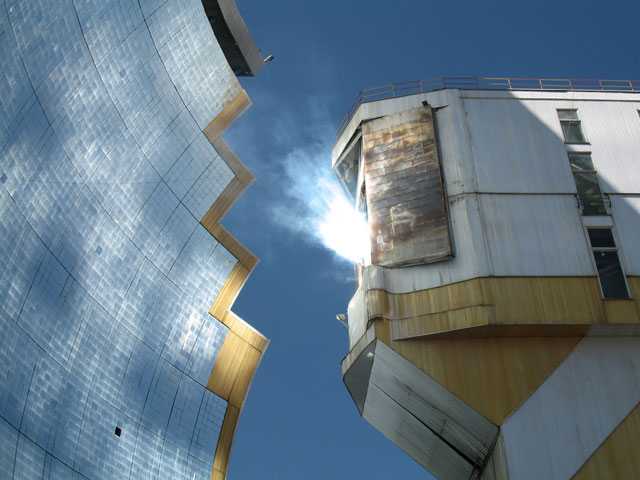According to a Greek text that was overwritten with Christian prayers, Archimedes worked out some of the principles of calculus over 1900 years before Newton and Leibniz. He called it The Method.
In The Method, Archimedes was working out a way to compute the areas and volumes of objects with curved surfaces, which was also one of the problems that motivated Newton and Leibniz. Ancient mathematicians had long struggled to “square the circle” by calculating its exact area. That problem turned out to be impossible using only a straightedge and compass, the only tools the ancient Greeks allowed themselves. Nevertheless, Archimedes worked out ways of computing the areas of many other curved regions.
Much more is explained in the book The Archimedes Codex. The entire text is available for free on Google Books (you might need this). (via long now)
A solar furnace is a structure used to harness the rays of the sun in order to produce high temperatures. This is achieved by using a curved mirror (or an array of mirrors) acting as a parabolic reflector to concentrate light (Insolation) on to a focal point. The temperature at the focal point may reach up to 3,000 degrees Celsius, and this heat can be used to generate electricity, melt steel or make hydrogen fuel.
Whoa! Here’s a great photo of a solar furnace in Uzbekistan and an even better photo of said furnace melting aluminum (close-up).

If you’ve got an old TV, you can use the Fresnel lens to make a solar furnace of your own. Caveats apply:
DANGER! This device is extremely dangerous. It should not be constructed or operated by anyone who does not observe proper safety precautions. It will instantly destroy flesh. It will melt metals, ceramics, and most any other material. Always wear welding goggles when operating this device! DO NOT leave this device unattended.
This DIY solar furnace is capable of melting brick (!!) and will “boil” a quarter in ~25 seconds.
Solar furnaces and the like have been around for centuries. In the 3rd century BC, Archimedes allegedly used a mirror to burn up the entire Roman fleet during the seige of Syracuse:
When Marcellus withdrew them [his ships] a bow-shot, the old man [Archimedes] constructed a kind of hexagonal mirror, and at an interval proportionate to the size of the mirror he set similar small mirrors with four edges, moved by links and by a form of hinge, and made it the centre of the sun’s beams—its noon-tide beam, whether in summer or in mid-winter. Afterwards, when the beams were reflected in the mirror, a fearful kindling of fire was raised in the ships, and at the distance of a bow-shot he turned them into ashes. In this way did the old man prevail over Marcellus with his weapons.
This assertion was tested at MIT and on Mythbusters with mixed results. (via delicious ghost)






Stay Connected